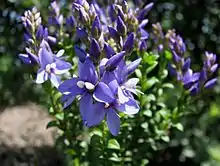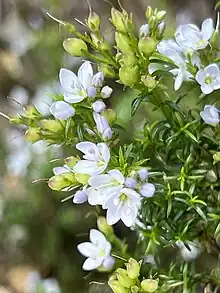| Veronica formosa | |
|---|---|
 | |
| Scientific classification | |
| Kingdom: | Plantae |
| Clade: | Tracheophytes |
| Clade: | Angiosperms |
| Clade: | Eudicots |
| Clade: | Asterids |
| Order: | Lamiales |
| Family: | Plantaginaceae |
| Genus: | Veronica |
| Species: | V. formosa |
| Binomial name | |
| Veronica formosa | |
| Synonyms | |
|
Derwentia formosa (R.Br.) Cockayne | |

White form
Veronica formosa is a flowering plant species of the family Plantaginaceae, endemic to Tasmania in Australia.[2] It is a subshrub which grows to between 0.5 and 2 metres high. The elliptic to lanceolate leaves are 7 to 15 mm long. The flowers are pale lilac or violet blue and appear in racemes from late spring to early summer.[1]
Cultivation
Plants may be grown in shade, but a position in full sun is desirable to maximise flowering. They are frost tolerant, being hardy to -7 °C. A compact shape can be maintained by cutting back old stems after flowering.[1]
References
Wikimedia Commons has media related to Veronica formosa.
- 1 2 3 Mulcahy, Tim (1986). "Veronica formosa". Growing Australian Plants. Australian National Botanic Gardens. Retrieved 21 January 2013.
- ↑ "Veronica formosa". Australian Plant Name Index (APNI), IBIS database. Centre for Plant Biodiversity Research, Australian Government, Canberra. Retrieved 21 January 2013.
This article is issued from Wikipedia. The text is licensed under Creative Commons - Attribution - Sharealike. Additional terms may apply for the media files.